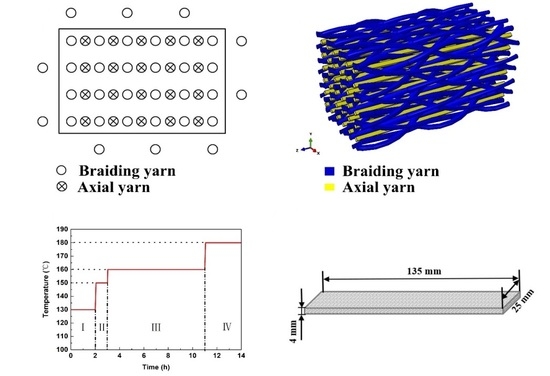Mechanical Characterization and Impact Damage Assessment of Hybrid Three-Dimensional Five-Directional Composites
Abstract
1. Introduction
2. Materials and Experiments
2.1. Materials
2.2. Sample Preparation
2.3. Tests
2.3.1. Quasi-Static Bending Tests
2.3.2. Dynamic Impact Test
2.3.3. Ultrasonic Non-Destructive Testing
3. Results and Discussions
3.1. Quasi-Static Mechanical Property
3.2. Dynamic Impact Property
3.3. Damage Morphology Analyses
3.4. Ultrasonic Non-Destructive Analyses
3.5. Impact Responsive Frequency Analyses
3.5.1. Frequency Domain Analyses via Fourier Transform
3.5.2. Time Domain Analyses via Wavelet Transform
4. Conclusions
Author Contributions
Funding
Conflicts of Interest
References
- Bilisik, K. Three-dimensional braiding for composites: A review. Text. Res. J. 2013, 83, 1414–1436. [Google Scholar] [CrossRef]
- Chen, L.; Tao, X.; Choy, C. Mechanical analysis of 3-d braided composites by the finite multiphase element method. Compos. Sci. Technol. 1999, 59, 2383–2391. [Google Scholar] [CrossRef]
- Zhou, H.; Li, C.; Zhang, L.; Crawford, B.; Milani, A.S.; Ko, F.K. Micro-xct analysis of damage mechanisms in 3d circular braided composite tubes under transverse impact. Compos. Sci. Technol. 2018, 155, 91–99. [Google Scholar] [CrossRef]
- Wang, Y.-Q.; Wang, A. Microstructure/property relationships in three-dimensionally braided fiber composites. Compos. Sci. Technol. 1995, 53, 213–222. [Google Scholar] [CrossRef]
- Zheng, Y.; Sun, Y.; Li, J.; Limin, L.; Chen, L.; Liu, J.; Tian, S. Tensile response of carbon-aramid hybrid 3d braided composites. Mater. Des. 2017, 116, 246–252. [Google Scholar] [CrossRef]
- Johnson, A.F.; Pickett, A.K.; Rozycki, P. Computational methods for predicting impact damage in composite structures. Compos. Sci. Technol. 2001, 61, 2183–2192. [Google Scholar] [CrossRef]
- Aymerich, F.; Dore, F.; Priolo, P. Prediction of impact-induced delamination in cross-ply composite laminates using cohesive interface elements. Compos. Sci. Technol. 2008, 68, 2383–2390. [Google Scholar] [CrossRef]
- Léonard, F.; Stein, J.; Soutis, C.; Withers, P.J. The quantification of impact damage distribution in composite laminates by analysis of x-ray computed tomograms. Compos. Sci. Technol. 2017, 152, 139–148. [Google Scholar] [CrossRef]
- Tehrani, M.; Boroujeni, A.Y.; Hartman, T.B.; Haugh, T.P.; Case, S.W.; Al-Haik, M.S. Mechanical characterization and impact damage assessment of a woven carbon fiber reinforced carbon nanotube-epoxy composite. Compos. Sci. Technol. 2013, 75, 42–48. [Google Scholar] [CrossRef]
- Moure, M.M.; Rubio, I.; Aranda-Ruiz, J.; Loya, J.A.; Rodríguez-Millán, M. Analysis of impact energy absorption by lightweight aramid structures. Compos. Struct. 2018, 203, 917–926. [Google Scholar] [CrossRef]
- Bandaru, A.K.; Patel, S.; Sachan, Y.; Alagirusamy, R.; Bhatnagar, N.; Ahmad, S. Low velocity impact response of 3d angle-interlock kevlar/basalt reinforced polypropylene composites. Mater. Des. 2016, 105, 323–332. [Google Scholar] [CrossRef]
- Hufenbach, W.; Gude, M.; Ebert, C. Hybrid 3d-textile reinforced composites with tailored property profiles for crash and impact applications. Compos. Sci. Technol. 2009, 69, 1422–1426. [Google Scholar] [CrossRef]
- Hayashi, T. On the improvement of mechanical properties of composites by hybrid composition. In Proceedings of the 8th International Reinforced Plastics Conference, Brighton, UK, 10–12 October 1972; pp. 149–152. [Google Scholar]
- Sevkat, E.; Liaw, B.; Delale, F. Drop-weight impact response of hybrid composites impacted by impactor of various geometries. Mater. Des. 2013, 52, 67–77. [Google Scholar] [CrossRef]
- Wan, Y.; Wang, Y.; He, F.; Huang, Y.; Jiang, H. Mechanical performance of hybrid bismaleimide composites reinforced with three-dimensional braided carbon and kevlar fabrics. Compos. Part A 2007, 38, 495–504. [Google Scholar] [CrossRef]
- Wan, Y.; Lian, J.; Huang, Y.; He, F.; Wang, Y.; Jiang, H.; Xin, J. Preparation and characterization of three-dimensional braided carbon/kevlar/epoxy hybrid composites. J. Mater. Sci. 2007, 42, 1343–1350. [Google Scholar] [CrossRef]
- Bunea, M.; Cîrciumaru, A.; Buciumeanu, M.; Bîrsan, I.G.; Silva, F.S. Low velocity impact response of fabric reinforced hybrid composites with stratified filled epoxy matrix. Compos. Sci. Technol. 2019, 169, 242–248. [Google Scholar] [CrossRef]
- Sarasini, F.; Tirillò, J.; Ferrante, L.; Valente, M.; Valente, T.; Lampani, L.; Gaudenzi, P.; Cioffi, S.; Iannace, S.; Sorrentino, L. Drop-weight impact behaviour of woven hybrid basalt–carbon/epoxy composites. Compos. Part B 2014, 59, 204–220. [Google Scholar] [CrossRef]
- Li, D.-s.; Lu, Z.-x.; Chen, L.; Li, J.-L. Microstructure and mechanical properties of three-dimensional five-directional braided composites. Inter. J. Solids Struct. 2009, 46, 3422–3432. [Google Scholar] [CrossRef]
- Inagaki, M. Carbon Materials Science And Engineering: From Fundamentals to Applications; Tsinghua University Press: Beijing, China, 2006. [Google Scholar]
- Volokhina, A.V. High-strength aramid fibres made from polymer blends. Fibre Chem. 2000, 32, 230–234. [Google Scholar] [CrossRef]
- Wang, X.; Hu, B.; Feng, Y.; Liang, F.; Mo, J.; Xiong, J.; Qiu, Y. Low velocity impact properties of 3d woven basalt/aramid hybrid composites. Compos. Sci. Technol. 2008, 68, 444–450. [Google Scholar] [CrossRef]
- Ma, P.; Hu, H.; Zhang, Y.; Sun, B.; Gu, B. Frequency features of co-woven-knitted fabric (cwkf) composite under tension at various strain rates. Compos. Part A 2011, 42, 446–452. [Google Scholar] [CrossRef]
- Zhang, Y.; Wang, P.; Guo, C. Energy absorption behaviors of 3d braided composites under impact loadings with frequency domain analysis. Polym. Compos. 2016, 37, 1620–1627. [Google Scholar] [CrossRef]
- Zhao, G.; Wang, B.; Wang, T.; Hao, W.; Luo, Y. Detection and monitoring of delamination in composite laminates using ultrasonic guided wave. Compos. Struct. 2019, 225, 111161. [Google Scholar] [CrossRef]
- Loutas, T.; Kostopoulos, V.; Ramirez-Jimenez, C.; Pharaoh, M. Damage evolution in center-holed glass/polyester composites under quasi-static loading using time/frequency analysis of acoustic emission monitored waveforms. Compos. Sci. Technol. 2006, 66, 1366–1375. [Google Scholar] [CrossRef]
- Sung, D.-U.; Kim, C.-G.; Hong, C.-S. Monitoring of impact damages in composite laminates using wavelet transform. Compos. Part B 2002, 33, 35–43. [Google Scholar] [CrossRef]
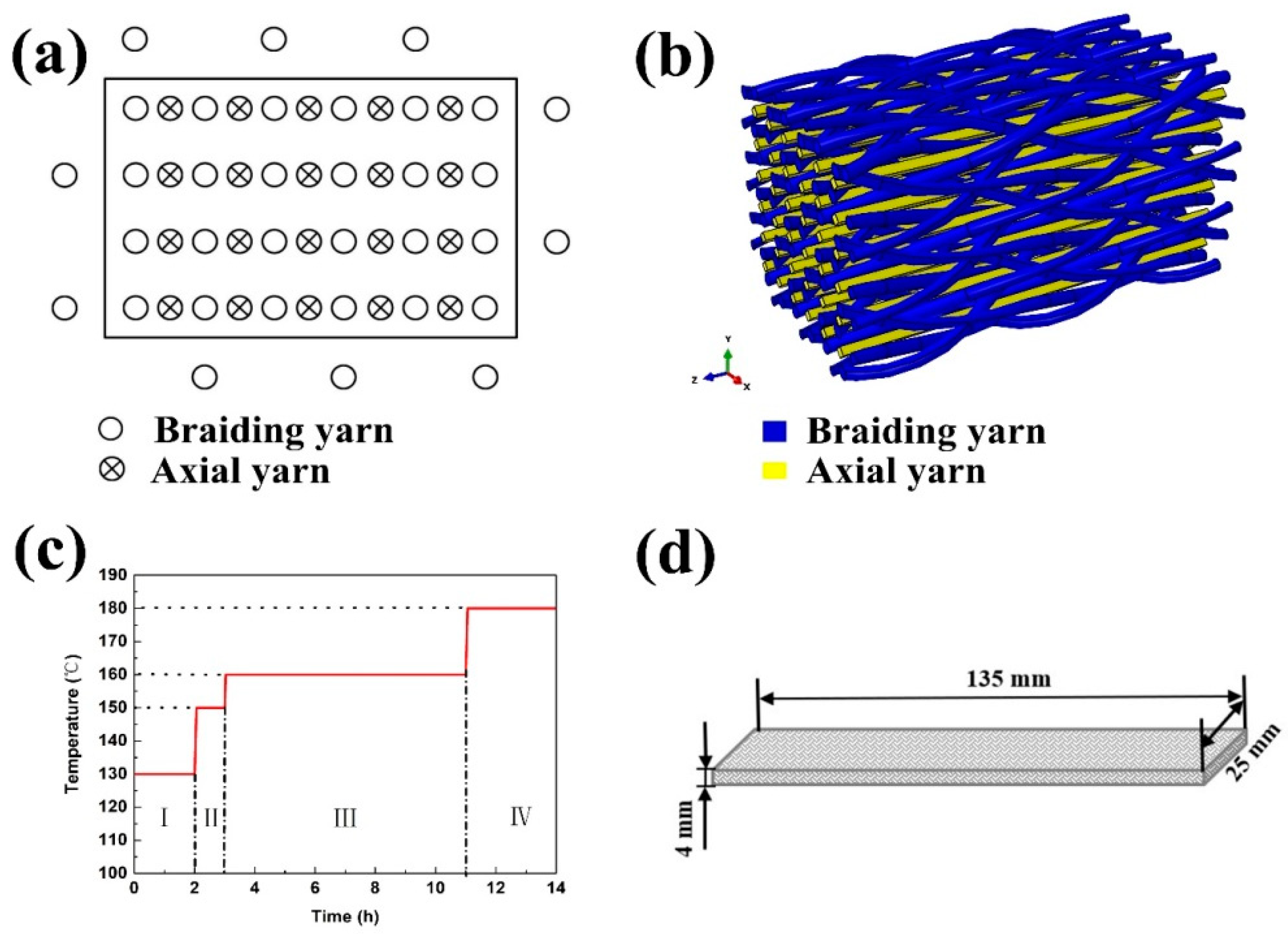
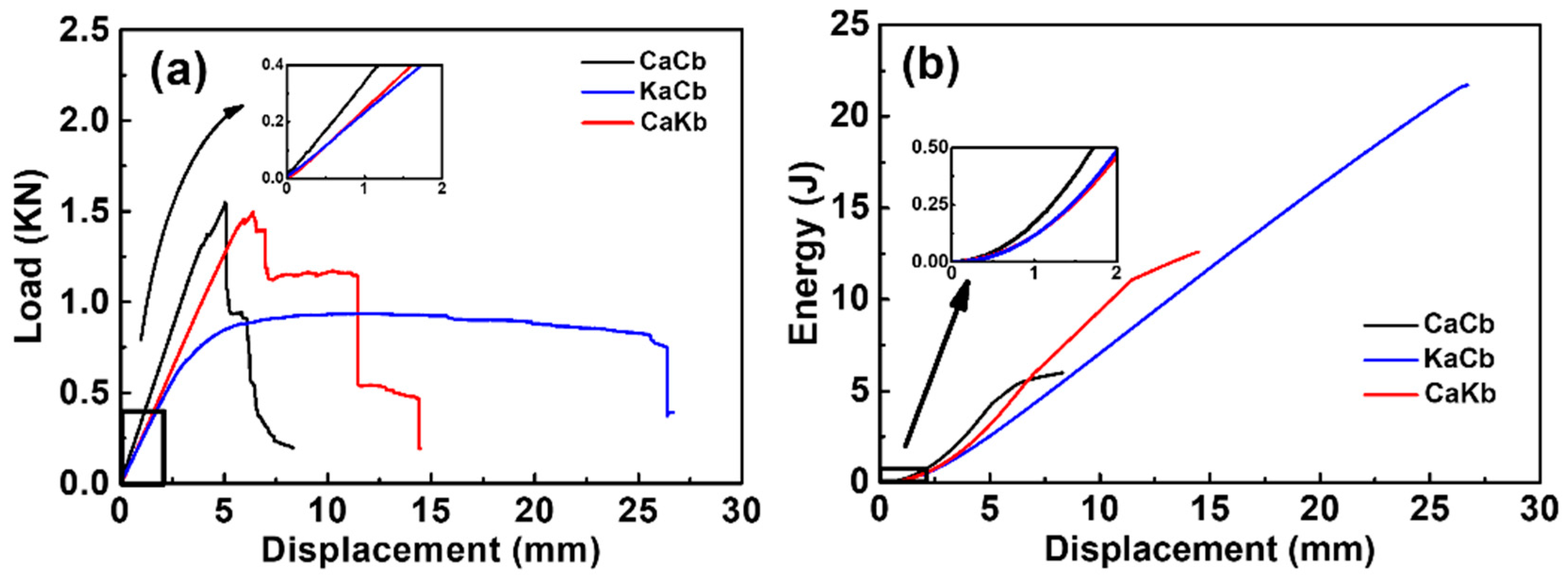


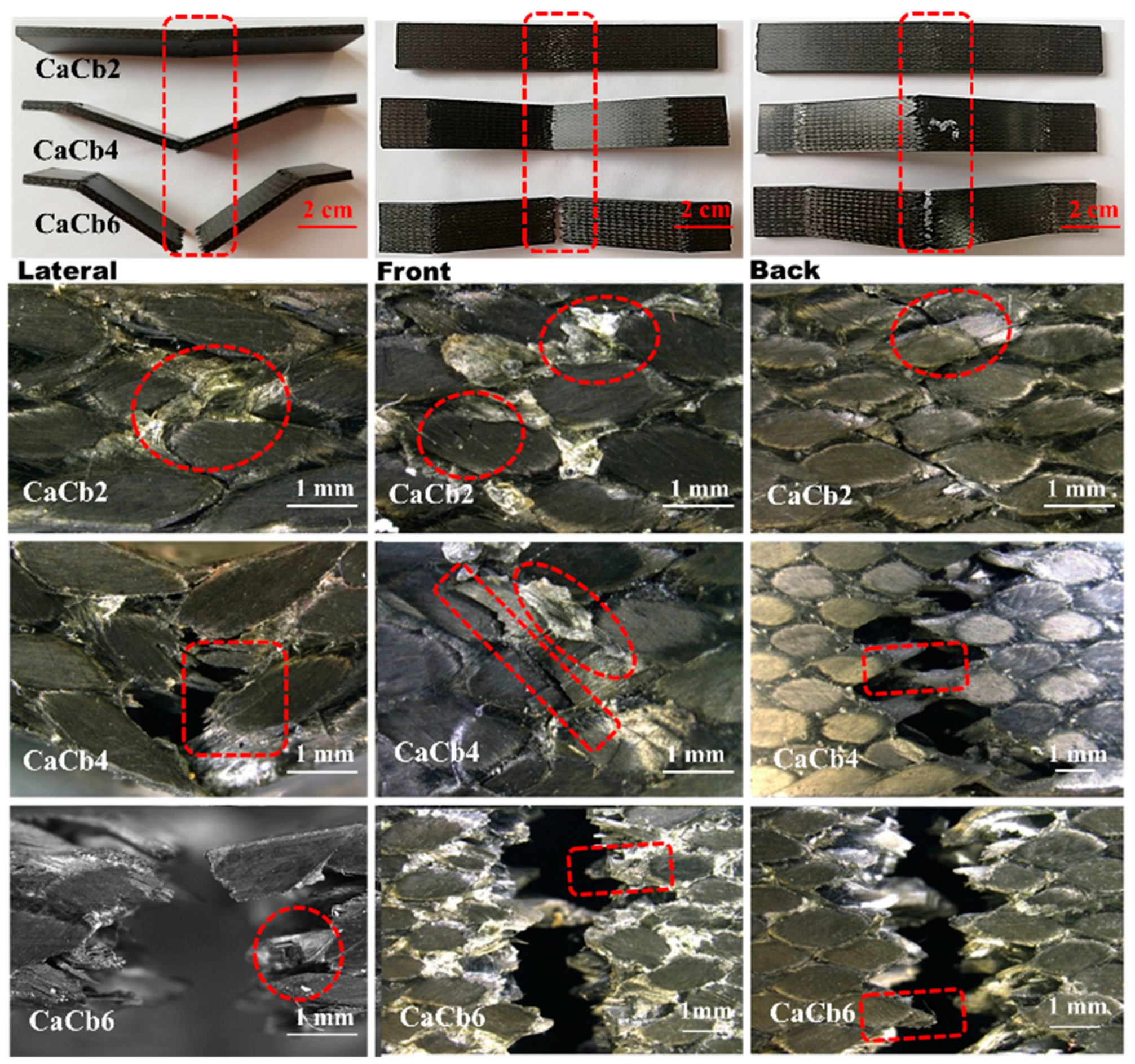
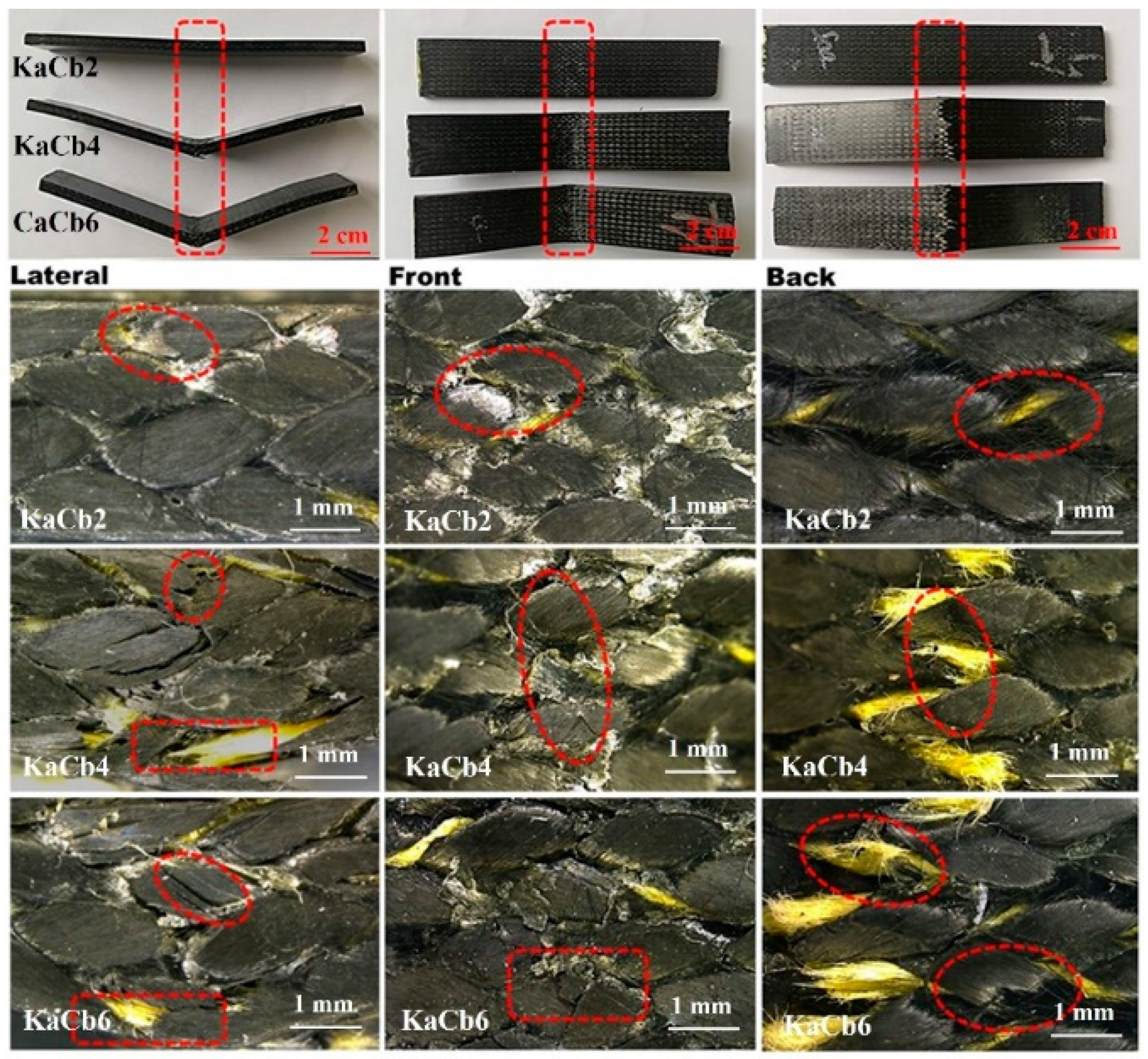
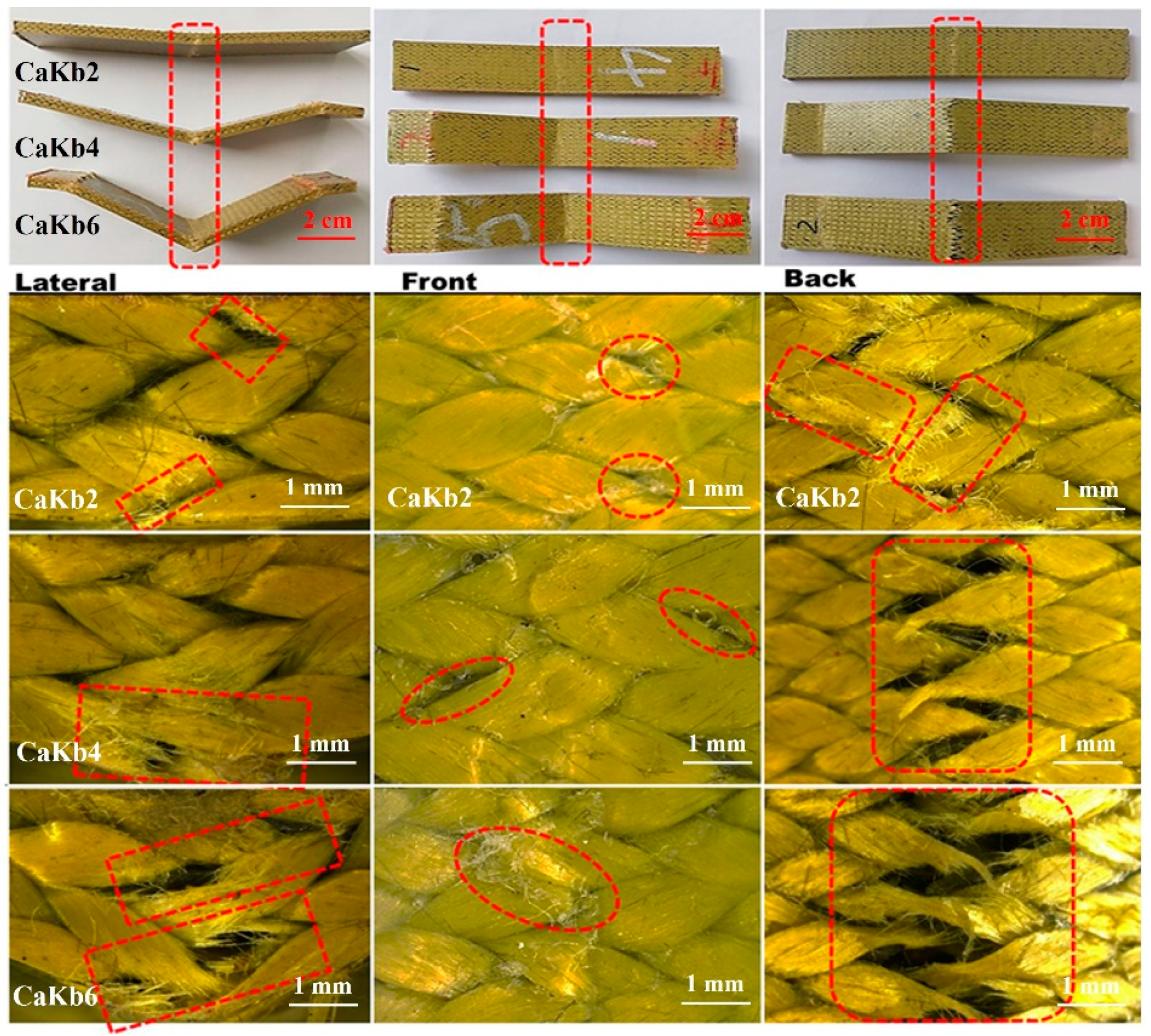
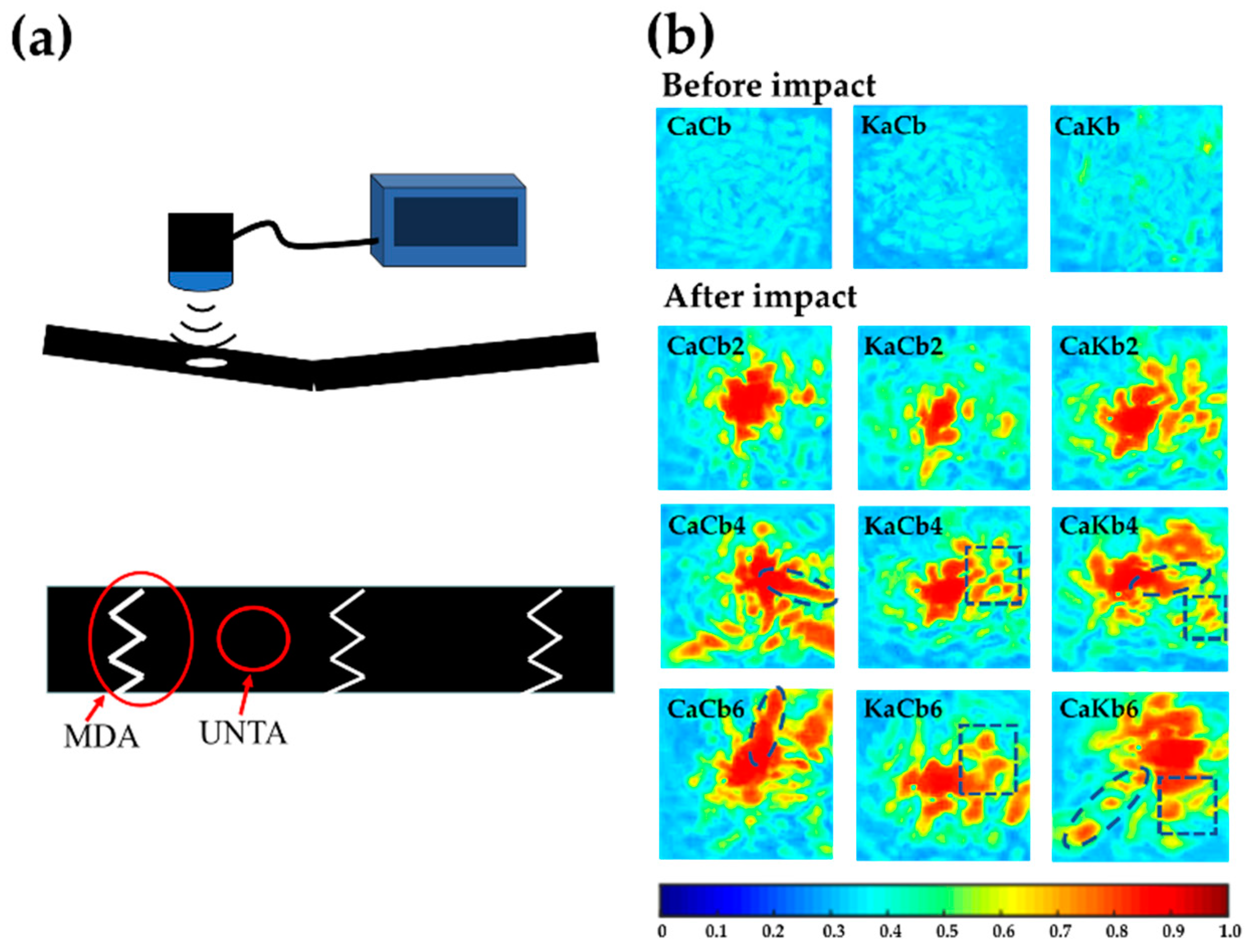
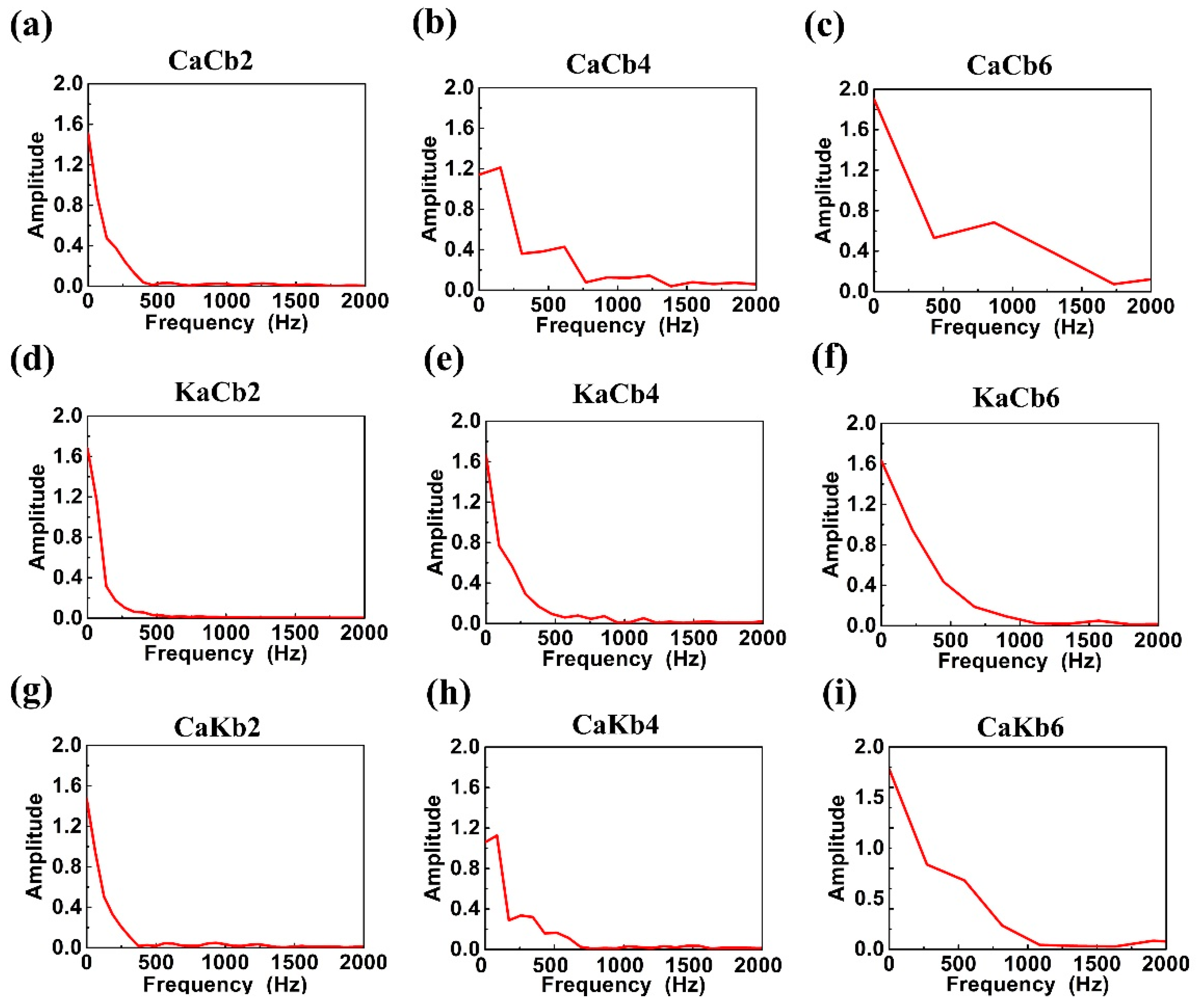
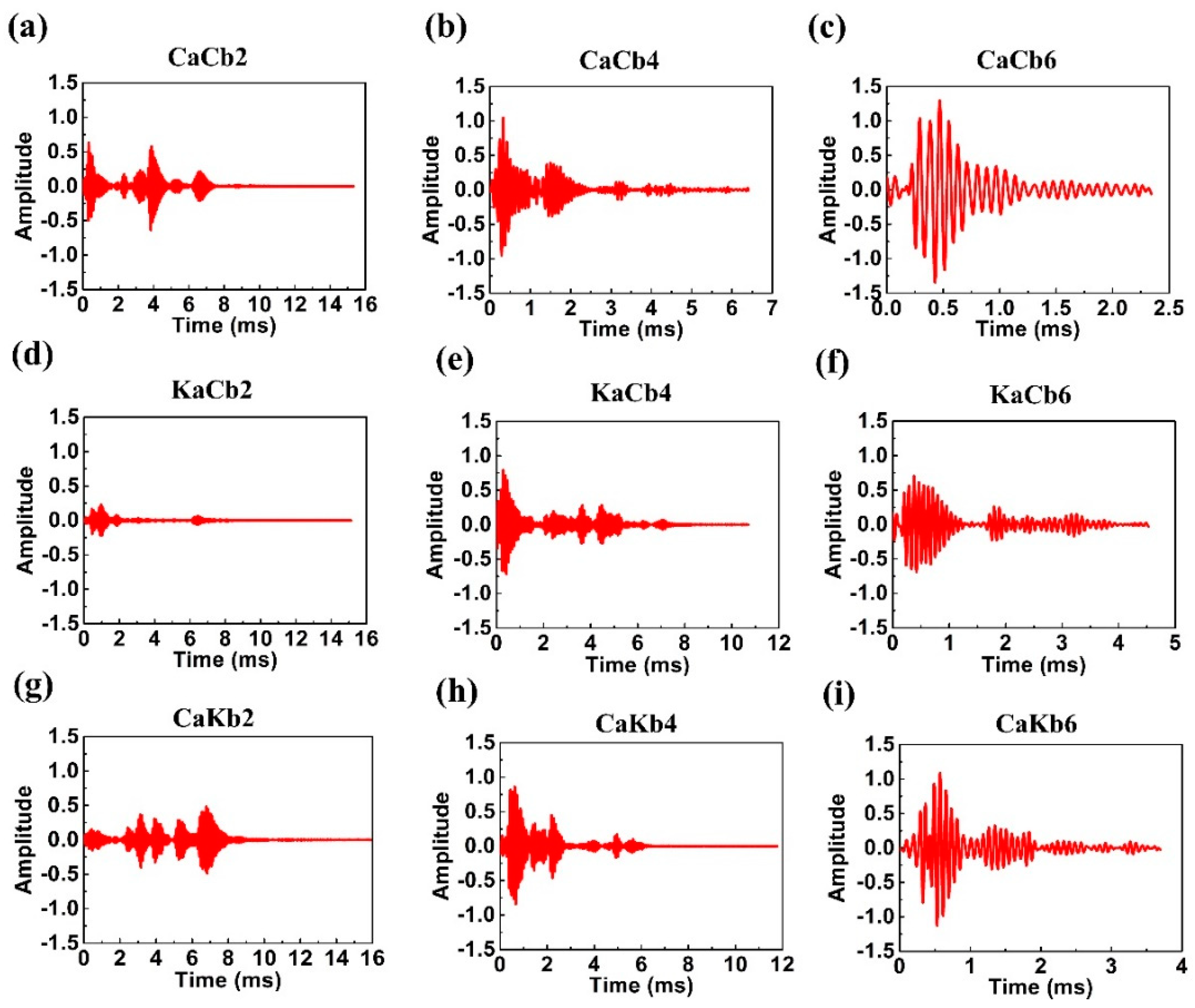
| Materials | Type | Strength (MPa) | Modulus (GPa) | Density (g/cm3) | Elongation (%) |
|---|---|---|---|---|---|
| Carbon fiber | T300-3K | 3530 | 230 | 1.76 | 1.5 |
| Aramid fiber | Kevlar49 | 2923 | 175 | 1.44 | 2.8 |
| Resin | TDE-86 | 80 | 3.5 | 1.13 | 4.0 |
| Type | Axial | Braid | Pick Length (mm) | Pick Width (mm) | Yarn Volume Content (%) |
|---|---|---|---|---|---|
| CaCb | T300-3K | T300-3K | 3 ± 0.1 | 2.2 ± 0.1 | T300-3K: 53% |
| KaCb | Kevlar49 | T300-3K | 3 ± 0.1 | 2.4 ± 0.1 | Kevlar49: 11%; T300-3K: 43% |
| CaKb | T300-3K | Kevlar49 | 3 ± 0.1 | 2.2 ± 0.1 | Kevlar49: 43%; T300-3K: 11% |
© 2019 by the authors. Licensee MDPI, Basel, Switzerland. This article is an open access article distributed under the terms and conditions of the Creative Commons Attribution (CC BY) license (http://creativecommons.org/licenses/by/4.0/).
Share and Cite
Wu, L.; Wang, W.; Jiang, Q.; Xiang, C.; Lou, C.-W. Mechanical Characterization and Impact Damage Assessment of Hybrid Three-Dimensional Five-Directional Composites. Polymers 2019, 11, 1395. https://doi.org/10.3390/polym11091395
Wu L, Wang W, Jiang Q, Xiang C, Lou C-W. Mechanical Characterization and Impact Damage Assessment of Hybrid Three-Dimensional Five-Directional Composites. Polymers. 2019; 11(9):1395. https://doi.org/10.3390/polym11091395
Chicago/Turabian StyleWu, Liwei, Wei Wang, Qian Jiang, Chunjie Xiang, and Ching-Wen Lou. 2019. "Mechanical Characterization and Impact Damage Assessment of Hybrid Three-Dimensional Five-Directional Composites" Polymers 11, no. 9: 1395. https://doi.org/10.3390/polym11091395
APA StyleWu, L., Wang, W., Jiang, Q., Xiang, C., & Lou, C.-W. (2019). Mechanical Characterization and Impact Damage Assessment of Hybrid Three-Dimensional Five-Directional Composites. Polymers, 11(9), 1395. https://doi.org/10.3390/polym11091395





